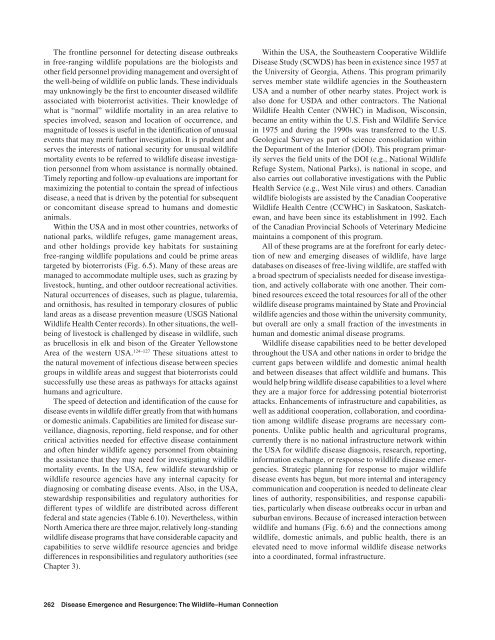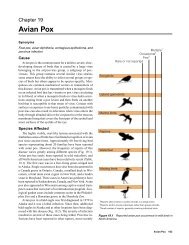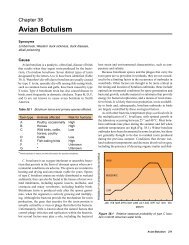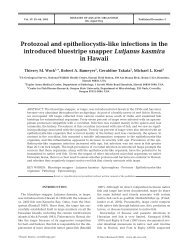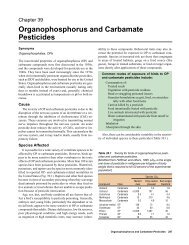Biowarfare, Bioterrorism, and Animal Diseases as Bioweapons
Biowarfare, Bioterrorism, and Animal Diseases as Bioweapons
Biowarfare, Bioterrorism, and Animal Diseases as Bioweapons
Create successful ePaper yourself
Turn your PDF publications into a flip-book with our unique Google optimized e-Paper software.
The frontline personnel for detecting dise<strong>as</strong>e outbreaks<br />
in free-ranging wildlife populations are the biologists <strong>and</strong><br />
other field personnel providing management <strong>and</strong> oversight of<br />
the well-being of wildlife on public l<strong>and</strong>s. These individuals<br />
may unknowingly be the first to encounter dise<strong>as</strong>ed wildlife<br />
<strong>as</strong>sociated with bioterrorist activities. Their knowledge of<br />
what is “normal” wildlife mortality in an area relative to<br />
species involved, se<strong>as</strong>on <strong>and</strong> location of occurrence, <strong>and</strong><br />
magnitude of losses is useful in the identification of unusual<br />
events that may merit further investigation. It is prudent <strong>and</strong><br />
serves the interests of national security for unusual wildlife<br />
mortality events to be referred to wildlife dise<strong>as</strong>e investigation<br />
personnel from whom <strong>as</strong>sistance is normally obtained.<br />
Timely reporting <strong>and</strong> follow-up evaluations are important for<br />
maximizing the potential to contain the spread of infectious<br />
dise<strong>as</strong>e, a need that is driven by the potential for subsequent<br />
or concomitant dise<strong>as</strong>e spread to humans <strong>and</strong> domestic<br />
animals.<br />
Within the USA <strong>and</strong> in most other countries, networks of<br />
national parks, wildlife refuges, game management are<strong>as</strong>,<br />
<strong>and</strong> other holdings provide key habitats for sustaining<br />
free-ranging wildlife populations <strong>and</strong> could be prime are<strong>as</strong><br />
targeted by bioterrorists (Fig. 6.5). Many of these are<strong>as</strong> are<br />
managed to accommodate multiple uses, such <strong>as</strong> grazing by<br />
livestock, hunting, <strong>and</strong> other outdoor recreational activities.<br />
Natural occurrences of dise<strong>as</strong>es, such <strong>as</strong> plague, tularemia,<br />
<strong>and</strong> ornithosis, h<strong>as</strong> resulted in temporary closures of public<br />
l<strong>and</strong> are<strong>as</strong> <strong>as</strong> a dise<strong>as</strong>e prevention me<strong>as</strong>ure (USGS National<br />
Wildlife Health Center records). In other situations, the wellbeing<br />
of livestock is challenged by dise<strong>as</strong>e in wildlife, such<br />
<strong>as</strong> brucellosis in elk <strong>and</strong> bison of the Greater Yellowstone<br />
Area of the western USA. 124–127 These situations attest to<br />
the natural movement of infectious dise<strong>as</strong>e between species<br />
groups in wildlife are<strong>as</strong> <strong>and</strong> suggest that bioterrorists could<br />
successfully use these are<strong>as</strong> <strong>as</strong> pathways for attacks against<br />
humans <strong>and</strong> agriculture.<br />
The speed of detection <strong>and</strong> identification of the cause for<br />
dise<strong>as</strong>e events in wildlife differ greatly from that with humans<br />
or domestic animals. Capabilities are limited for dise<strong>as</strong>e surveillance,<br />
diagnosis, reporting, field response, <strong>and</strong> for other<br />
critical activities needed for effective dise<strong>as</strong>e containment<br />
<strong>and</strong> often hinder wildlife agency personnel from obtaining<br />
the <strong>as</strong>sistance that they may need for investigating wildlife<br />
mortality events. In the USA, few wildlife stewardship or<br />
wildlife resource agencies have any internal capacity for<br />
diagnosing or combating dise<strong>as</strong>e events. Also, in the USA,<br />
stewardship responsibilities <strong>and</strong> regulatory authorities for<br />
different types of wildlife are distributed across different<br />
federal <strong>and</strong> state agencies (Table 6.10). Nevertheless, within<br />
North America there are three major, relatively long-st<strong>and</strong>ing<br />
wildlife dise<strong>as</strong>e programs that have considerable capacity <strong>and</strong><br />
capabilities to serve wildlife resource agencies <strong>and</strong> bridge<br />
differences in responsibilities <strong>and</strong> regulatory authorities (see<br />
Chapter 3).<br />
262 Dise<strong>as</strong>e Emergence <strong>and</strong> Resurgence: The Wildlife–Human Connection<br />
Within the USA, the Southe<strong>as</strong>tern Cooperative Wildlife<br />
Dise<strong>as</strong>e Study (SCWDS) h<strong>as</strong> been in existence since 1957 at<br />
the University of Georgia, Athens. This program primarily<br />
serves member state wildlife agencies in the Southe<strong>as</strong>tern<br />
USA <strong>and</strong> a number of other nearby states. Project work is<br />
also done for USDA <strong>and</strong> other contractors. The National<br />
Wildlife Health Center (NWHC) in Madison, Wisconsin,<br />
became an entity within the U.S. Fish <strong>and</strong> Wildlife Service<br />
in 1975 <strong>and</strong> during the 1990s w<strong>as</strong> transferred to the U.S.<br />
Geological Survey <strong>as</strong> part of science consolidation within<br />
the Department of the Interior (DOI). This program primarily<br />
serves the field units of the DOI (e.g., National Wildlife<br />
Refuge System, National Parks), is national in scope, <strong>and</strong><br />
also carries out collaborative investigations with the Public<br />
Health Service (e.g., West Nile virus) <strong>and</strong> others. Canadian<br />
wildlife biologists are <strong>as</strong>sisted by the Canadian Cooperative<br />
Wildlife Health Centre (CCWHC) in S<strong>as</strong>katoon, S<strong>as</strong>katchewan,<br />
<strong>and</strong> have been since its establishment in 1992. Each<br />
of the Canadian Provincial Schools of Veterinary Medicine<br />
maintains a component of this program.<br />
All of these programs are at the forefront for early detection<br />
of new <strong>and</strong> emerging dise<strong>as</strong>es of wildlife, have large<br />
datab<strong>as</strong>es on dise<strong>as</strong>es of free-living wildlife, are staffed with<br />
a broad spectrum of specialists needed for dise<strong>as</strong>e investigation,<br />
<strong>and</strong> actively collaborate with one another. Their combined<br />
resources exceed the total resources for all of the other<br />
wildlife dise<strong>as</strong>e programs maintained by State <strong>and</strong> Provincial<br />
wildlife agencies <strong>and</strong> those within the university community,<br />
but overall are only a small fraction of the investments in<br />
human <strong>and</strong> domestic animal dise<strong>as</strong>e programs.<br />
Wildlife dise<strong>as</strong>e capabilities need to be better developed<br />
throughout the USA <strong>and</strong> other nations in order to bridge the<br />
current gaps between wildlife <strong>and</strong> domestic animal health<br />
<strong>and</strong> between dise<strong>as</strong>es that affect wildlife <strong>and</strong> humans. This<br />
would help bring wildlife dise<strong>as</strong>e capabilities to a level where<br />
they are a major force for addressing potential bioterrorist<br />
attacks. Enhancements of infr<strong>as</strong>tructure <strong>and</strong> capabilities, <strong>as</strong><br />
well <strong>as</strong> additional cooperation, collaboration, <strong>and</strong> coordination<br />
among wildlife dise<strong>as</strong>e programs are necessary components.<br />
Unlike public health <strong>and</strong> agricultural programs,<br />
currently there is no national infr<strong>as</strong>tructure network within<br />
the USA for wildlife dise<strong>as</strong>e diagnosis, research, reporting,<br />
information exchange, or response to wildlife dise<strong>as</strong>e emergencies.<br />
Strategic planning for response to major wildlife<br />
dise<strong>as</strong>e events h<strong>as</strong> begun, but more internal <strong>and</strong> interagency<br />
communication <strong>and</strong> cooperation is needed to delineate clear<br />
lines of authority, responsibilities, <strong>and</strong> response capabilities,<br />
particularly when dise<strong>as</strong>e outbreaks occur in urban <strong>and</strong><br />
suburban environs. Because of incre<strong>as</strong>ed interaction between<br />
wildlife <strong>and</strong> humans (Fig. 6.6) <strong>and</strong> the connections among<br />
wildlife, domestic animals, <strong>and</strong> public health, there is an<br />
elevated need to move informal wildlife dise<strong>as</strong>e networks<br />
into a coordinated, formal infr<strong>as</strong>tructure.


